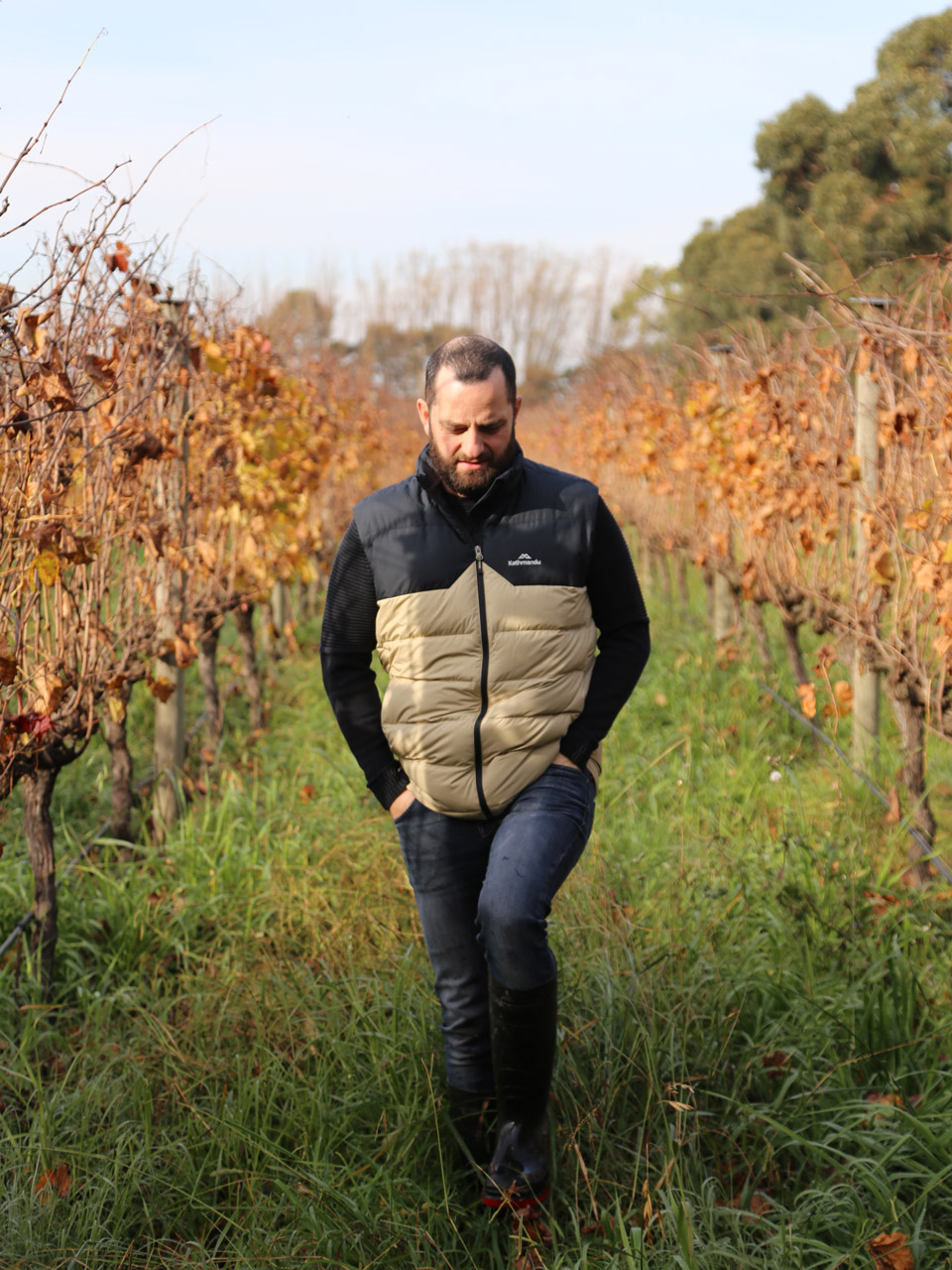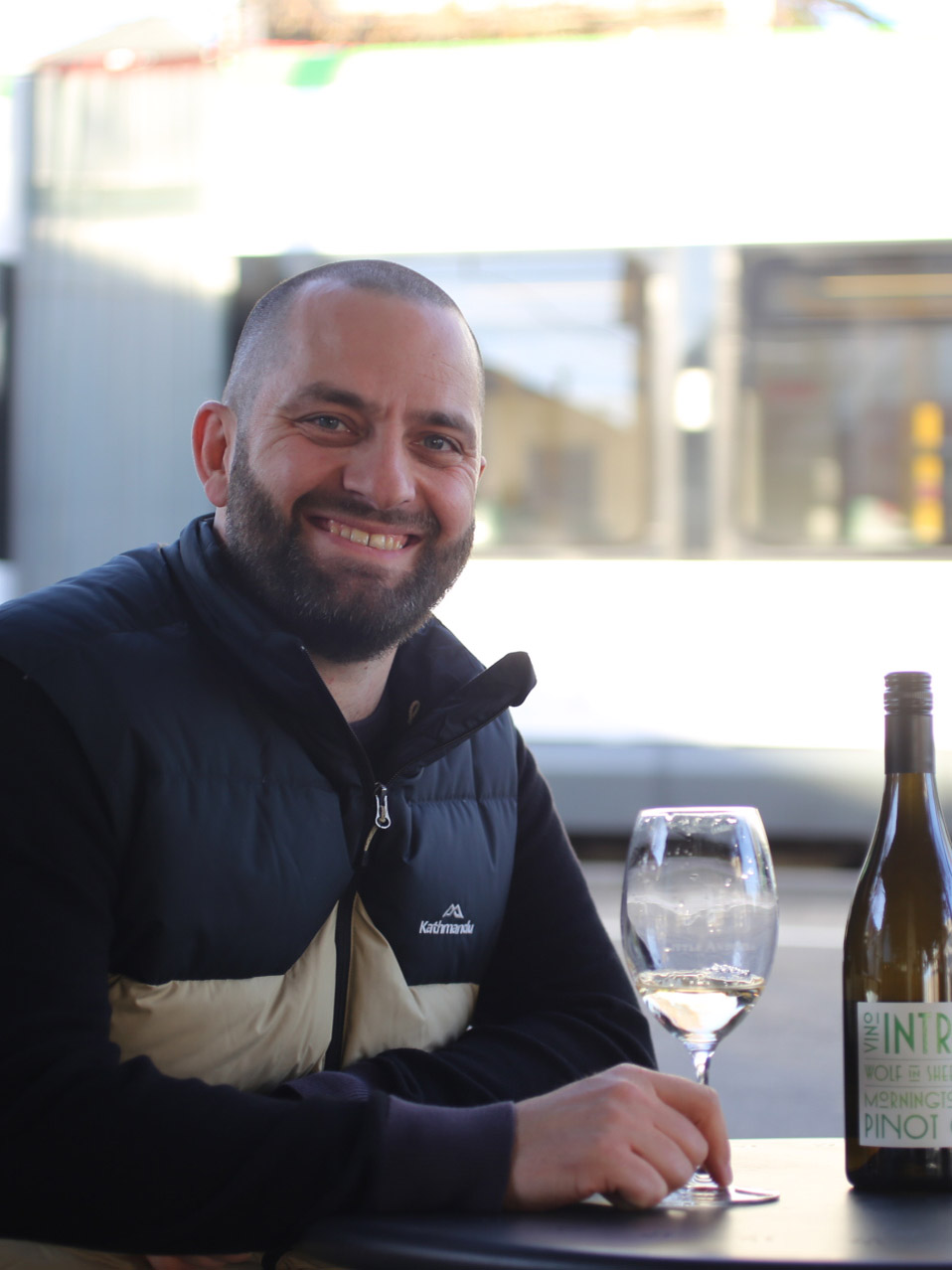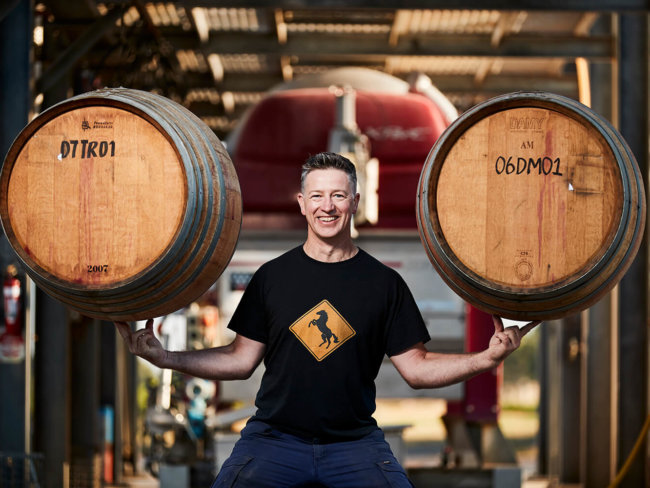Vino Intrepido is a natural continuation for James Scarcebrook’s long-term connection with Italian wine, from fine-wine retail and extensive wine-focused travel to wholesaling some of Italy’s best wines. His range, which was launched in 2016 with two wines, has grown to include a suite of Italian varieties, including sangiovese, nebbiolo, fiano and nero d’avola. The grapes are all sourced from Victorian vineyards, then made in a way that takes inspiration from traditional Italian methods but is carefully tuned to be sympathetic to the natural expression of individual sites and seasons.
“2021 was the biggest vintage in terms of volumes, number of wines, and branching out into new styles and varieties,” says Scarcebrook, noting the growth since devoting his main attention to the Vino Intrepido label in 2020. “Col fondo prosecco, pét-nat lambrusco, skin-contact vermentino, ramato pinot grigio and dolcetto were all new. 2022 continue all these new styles and varieties, and for 2023, I added montepulciano for a planned Cerasuolo d’Abruzzo style. Heathcote sangiovese is back for the first time since 2020, with two styles planned… negroamaro for a robust and structured style, and a few new vineyard sources as well.”
Scarcebrook started his career in wine with a job in retail, in 2004, with cellar door duty following at the Yarra Valley’s Domaine Chandon. After graduating as a Master of Wine Business from The University of Adelaide, he set off on a 16-month global wine tour, visiting wineries in ten countries, including working vintage at two wineries in Germany in 2012.
“For me, it is vital that the right varieties are selected from the right source. I do not necessarily want to make wine from an Italian variety because I can, I want to find a correlation with a local region and a region in Italy, to attempt to show the variety at its full potential.”
Once home, Scarcebrook started his Vincast podcast series, while also working for two leading Sydney-based importers of Italian wine as their Melbourne representative for a total of nearly seven years. In 2016, the first Vino Intrepido wines were launched, but it was in 2019 that Scarcebrook went all in, rebooting the label and expanding the range to capture a brace of key Italian varieties.
That exclusive focus on Vino Intrepido initially saw him set up a home base at Bangholme, in Melbourne’s south-east. “Since I started making my own wine I have worked closely with experienced winemakers in collaboration and conjunction, and I have appreciated that shared creative space,” says Scarcebrook, who notes that he has since moved to Melbourne Polytechnic in Epping where that collaboration continues.
“2021 was my first true fulltime vintage, increasing tonnage from 13 to 30, and the number of wines from six to 11. I changed winery and began working with Mark Matthews at The Wine Creche, and I’m in my third vintage there,” Scarcebrook says, noting that his sparkling wines are produced in conjunction with sparkling wine specialists Kilchurn in Romsey.
With minimal winery experience until he began his own label, Scarcebrook credits working alongside experienced operators with helping him to realise his ideas. “For the most part, I am testing theories I have developed,” he says. “And, for the most part, I have been incredibly lucky to make wines that are close to my intention. I have learned the hard way about working with the grower and the fruit, rather than stubbornly sticking to the original plan and trying to get something out of grapes that are not suited for a style.”
With ample history with Italian wines over his years selling them, plus extensive travels in the country, the focus of Vino Intrepido is perhaps not surprising, but there’s more to it than that. Scarcebrook saw great potential for Italian varieties across the great diversity of Victorian growing conditions, from the cool and maritime to the hot and rugged.
“Italian varieties’ ability to often ripen later and retain acidity helps keep the wines flavourful and fresh. I also select varieties that reach flavour ripeness at lower sugar levels, to keep alcohol levels at a balanced place. Picking at the right time and not fucking it up in the winery is how I try to work.”
“For me, it is vital that the right varieties are selected from the right source. I do not necessarily want to make wine from an Italian variety because I can, I want to find a correlation with a local region and a region in Italy, to attempt to show the variety at its full potential. I’m attempting to capture the best drinkable elements of Italian wine through the prism of Victorian vineyards and climates, working in a simple and honest way to express grape and origin.”
The other factor that deeply influenced his decision was climate change, with Scarcebrook believing in the varieties’ general suitability not just to today’s already hotter and drier conditions, but for what he sees as an ongoing trend of warming. “Italian varieties’ ability to often ripen later and retain acidity helps keep the wines flavourful and fresh. I also select varieties that reach flavour ripeness at lower sugar levels, to keep alcohol levels at a balanced place. Picking at the right time and not fucking it up in the winery is how I try to work.”
That approach in the winery sees traditional methods employed, with Scarcebrook noting he takes inspiration from classic Italian practices, but always with the fruit profile that comes off the site prioritised. “Expression of soils and climate is important, not to mention drinkability for the end consumer,” he says. “For me, minimal intervention is about keeping things simple and doing what is necessary to preserve authenticity and freshness.
“Most wines are made with spontaneous fermentation and without fining or filtration. Sulphur is added minimally and when necessary, reacting rather than prescribing… No cold soaking is performed, but in some cases post-ferment maceration is used. For example, sangiovese spends a month on skins, whereas nebbiolo spends at least eight weeks on skins. Mature and/or large-format wood is preferred.”
Scarcebrook notes that one of his biggest lessons is to be patient, and to not rush the process. “This applies to the way they hold their acidity as they reach flavour ripeness on the vine, the way they can sometimes go into slightly funky stages when fermenting, and particularly once they are in bottle. This is particularly the case with the Mornington Peninsula fiano, which can really shut down at particular stages, but give it time and it absolutely sings.”
While the offering has consistently grown over the last few years, Scarcebrook says he is beginning to streamline the range. “I’m focusing on the varieties and styles I’m more passionate about with some scope for experimentation, while also introducing a few new varieties for the 2023 vintage. …Focusing a bit more on cool climate as well. …I’d like to encourage growers in key regions to plant specific varieties for me, dependent on varietal availability, soil composition and climate. I’d also like to work in more volcanic warm and cool climate areas.”







